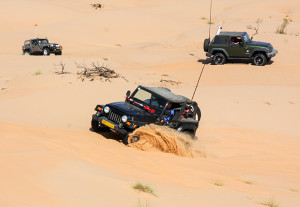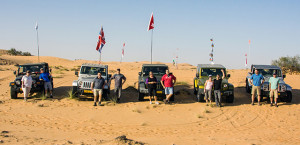Words + Photos By: Darryl MacDonald
When my wife and I first moved to Oman, several years ago, I heard rumors about a desert race called the Wahiba Challenge. Having no previous experience in this part of the world, my imagination conjured up images of the Baja 1000, the Desert Mint and the Sahara Desert Race, and I was determined to take part. So, promptly after arriving in Oman, I searched out the appropriate off-road vehicle. Not too old, so I wouldn’t have to fill the vehicle with spare parts and tools and not so new that I might spend several nights crying myself to sleep should something tragic happen to the vehicle (most insurance doesn’t cover dune bashing). I settled on an unmodified 2007 Jeep Wrangler and dutifully began appropriating and adding bits and pieces to get it through the desert with minimal damage and maximum efficiency. When the time came and the organisation for the event began, I was ready.  The Wahiba dunes are approximately 180km long and 90km wide with some of the dunes reaching over 100m in height. There are still a few Bedouin tribes roaming around the area, but the vast majority of the Wahiba is devoid of people. The event, which isn’t technically considered a race, takes place annually and is put on by local off-road club, meaning unfortunately that it is not open to the general public. The concept was simple; each team must have a minimum of four vehicles (for safety purposes) and each vehicle must contain two people. Teams have two days to cross the Wahiba and are given coordinates for the starting point, the camp site after the first day and the finish line. My wife and I decided early that our team would consist solely of jeeps in order to fully enjoy the crossing without too much digging. Some people complain the jeeps are too easy, but I think they just give you access to some of the more difficult terrain. Forty-eight hours before the event, the coordinates to the starting point are emailed to the team captains, and then the crowd begins to mobilise. Now if you recall, this was my first outing into the Wahiba, or any desert for that matter. So the sight of over 120 souped-up, off-road vehicles in this barren landscape was astounding! It was like something straight out of a Mad Max movie. I was flabbergasted and excited!
The Wahiba dunes are approximately 180km long and 90km wide with some of the dunes reaching over 100m in height. There are still a few Bedouin tribes roaming around the area, but the vast majority of the Wahiba is devoid of people. The event, which isn’t technically considered a race, takes place annually and is put on by local off-road club, meaning unfortunately that it is not open to the general public. The concept was simple; each team must have a minimum of four vehicles (for safety purposes) and each vehicle must contain two people. Teams have two days to cross the Wahiba and are given coordinates for the starting point, the camp site after the first day and the finish line. My wife and I decided early that our team would consist solely of jeeps in order to fully enjoy the crossing without too much digging. Some people complain the jeeps are too easy, but I think they just give you access to some of the more difficult terrain. Forty-eight hours before the event, the coordinates to the starting point are emailed to the team captains, and then the crowd begins to mobilise. Now if you recall, this was my first outing into the Wahiba, or any desert for that matter. So the sight of over 120 souped-up, off-road vehicles in this barren landscape was astounding! It was like something straight out of a Mad Max movie. I was flabbergasted and excited!  The following morning everyone was up early to prepare for the day ahead. As I began to load up gear into my jeep, I noted in utter disappointment that I had acquired a flat tyre from a large thorn stuck into the sidewall of my brand new tyres – tyres that I had put on the jeep the week before. This was not a good start to the day. Thankfully, we had a well-organised team. Within the blink of an eye, the jeep was up on a jack, the tyre was changed and we were off to the starting line to pick up our coordinates for the day. Everyone gathered at the start line, the organisers covered the rules and regulations which included; not following any other teams tracks, avoid going near any of the Bedouin camps or animals, never leave a single vehicle alone and not a single piece of rubbish was to be left behind; simple and to the point.
The following morning everyone was up early to prepare for the day ahead. As I began to load up gear into my jeep, I noted in utter disappointment that I had acquired a flat tyre from a large thorn stuck into the sidewall of my brand new tyres – tyres that I had put on the jeep the week before. This was not a good start to the day. Thankfully, we had a well-organised team. Within the blink of an eye, the jeep was up on a jack, the tyre was changed and we were off to the starting line to pick up our coordinates for the day. Everyone gathered at the start line, the organisers covered the rules and regulations which included; not following any other teams tracks, avoid going near any of the Bedouin camps or animals, never leave a single vehicle alone and not a single piece of rubbish was to be left behind; simple and to the point.
By 8:30am, the starting gun was sounded and we were off. At first it was a bit crowded, with over 120 vehicles looking for a suitable entry point into the sands, but within the first hour our team was all alone in the desert. In fact, I only actually recall seeing two other teams off in the distance that afternoon. It wasn’t until we neared the camp site coordinates for the day that we started to see anyone else. So, it wasn’t the Baha 1000 type event that I had expected, but it was still far different that anything I had done before and it was still awesome. That day, we picked our way over 40km of dunes. Some areas were easy, while in other places we attempted some of the more difficult terrain. Most of the problems we encountered were easily fixed with a snatch strap or a quick push; that is until 3km from the finish line, when we noticed the fountain of brake fluid spewing out from under the lead jeep. After a brief rest and several of us poking around under the vehicle, we surmised that it was the best case scenario for a bad event. The brake line had severed only an inch from the wheel, meaning that after about an hour of poking and prodding the underbelly of the jeep, a temporary fix was in place and we made it to the evening’s destination before the cut off time. That night reparations were made from the events of the day, and preparations were made for the next day, the final day of the event. There were small celebrations scattered throughout the sand dunes over the course of the evening, and after an elaborate three course meal, we headed to bed so as to get an early start the following morning. The distance for the final day was less than the first day, but as we neared the end, the sand became softer and the terrain became more difficult to maneuver through. With one vehicle crippled by a damaged brake line and me having no spare tyre, we moved with a little more caution. None of the team was excited about the thought of having a vehicle towed out from the desert. Then, after four short hours of picking our way through the dunes, we crossed the finish line, with our vehicles intact. In the end, it wasn’t the epic thrilling cutthroat race my imagination had drummed up but something entirely different and, in many ways, just as exciting. Dune bashing is definitely one of the highlights that Oman has to offer. With the right preparation and appropriate gear, this can be an exciting once-in-a-lifetime experience. Don’t forget to carry plenty of water, sun protection and never cross with less than three vehicles. So get out there, have fun and, as we like to say in Canada, “keep your stick on the ice.” Darryl



